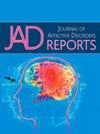在第一波COVID-19大流行之前和期间,加拿大的睡眠和饮食失调之间的关系
Q3 Psychology
引用次数: 0
摘要
饮食失调(EDs)患者普遍存在睡眠障碍,但在COVID-19大流行期间,关于饮食失调与睡眠之间相互作用的研究有限。本研究的目的是比较1)大流行前(回顾性)患有急诊科、缓解急诊科和对照组(无精神病史)患者自我报告的睡眠质量;2)大流行之前和期间这些群体之间的睡眠质量差异。方法参与者(N = 1033)完成匹兹堡睡眠质量指数,并报告大流行发病前一个月(回顾性)和大流行期间的焦虑和抑郁症状。单向ANCOVAs比较了大流行前各组的睡眠质量,调整了焦虑和抑郁症状以及人口统计数据。重复测量ANCOVAs评估了大流行之前和期间的睡眠质量差异,控制了相同的协变量。结果大流行前,患有急症的个体报告的睡眠障碍水平最高,其次是急症缓解者和对照组(F (2,955) = 11.01, p <;0.001)。在大流行期间,所有组的睡眠障碍都恶化了,即使考虑到焦虑和抑郁症状,当前和缓解ED组的个体也比对照组经历了更严重的恶化(p <;0.05)。局限性:睡眠质量的横断面设计和回顾性自我报告。结论:当前和缓解的ed患者在疫情期间似乎更容易受到睡眠中断的影响。在ED缓解期间,睡眠中断可能持续存在。对这些动态的认识可以提高心理健康从业者对当前或已缓解的成人急症患者睡眠中断的关注。本文章由计算机程序翻译,如有差异,请以英文原文为准。
The association between sleep and eating disorders in Canada before and during the first wave of the COVID-19 pandemic
Background
Sleep disturbances are prevalent among individuals with eating disorders (EDs), yet limited research has explored the interplay between EDs and sleep during the COVID-19 pandemic. This study aimed to compare 1) self-reported sleep quality before the pandemic (retrospectively) among individuals with current EDs, remitted EDs, and controls (no psychiatric history); and 2) sleep quality differences among these groups from before to during the pandemic.
Methods
Participants (N = 1033) completed the Pittsburgh Sleep Quality Index and reported anxiety and depression symptoms for the month before the pandemic onset (retrospectively) and during the pandemic. One-way ANCOVAs compared sleep quality among groups before the pandemic, adjusting for anxiety and depression symptoms and demographics. Repeated measures ANCOVAs assessed sleep quality differences between before and during the pandemic, controlling for the same covariates.
Results
Pre-pandemic, individuals with current EDs reported the highest sleep disturbance levels, followed by those with remitted EDs and controls (F (2, 955) = 11.01, p < 0.001). During the pandemic, sleep disturbance worsened across all groups, with individuals in current and remitted ED groups experiencing a more significant deterioration than controls, even when accounting for anxiety and depression symptoms (p < 0.05).
Limitations
The cross-sectional design and retrospective self-reports of sleep quality.
Conclusions
Individuals with current and remitted EDs seemed to be vulnerable to sleep disruptions during the pandemic. Sleep disruptions may persist during ED remission. Awareness of these dynamics can enhance mental health practitioners’ attention to sleep disruptions in adults with current or remitted EDs.
求助全文
通过发布文献求助,成功后即可免费获取论文全文。
去求助
来源期刊

Journal of Affective Disorders Reports
Psychology-Clinical Psychology
CiteScore
3.80
自引率
0.00%
发文量
137
审稿时长
134 days
 求助内容:
求助内容: 应助结果提醒方式:
应助结果提醒方式:


